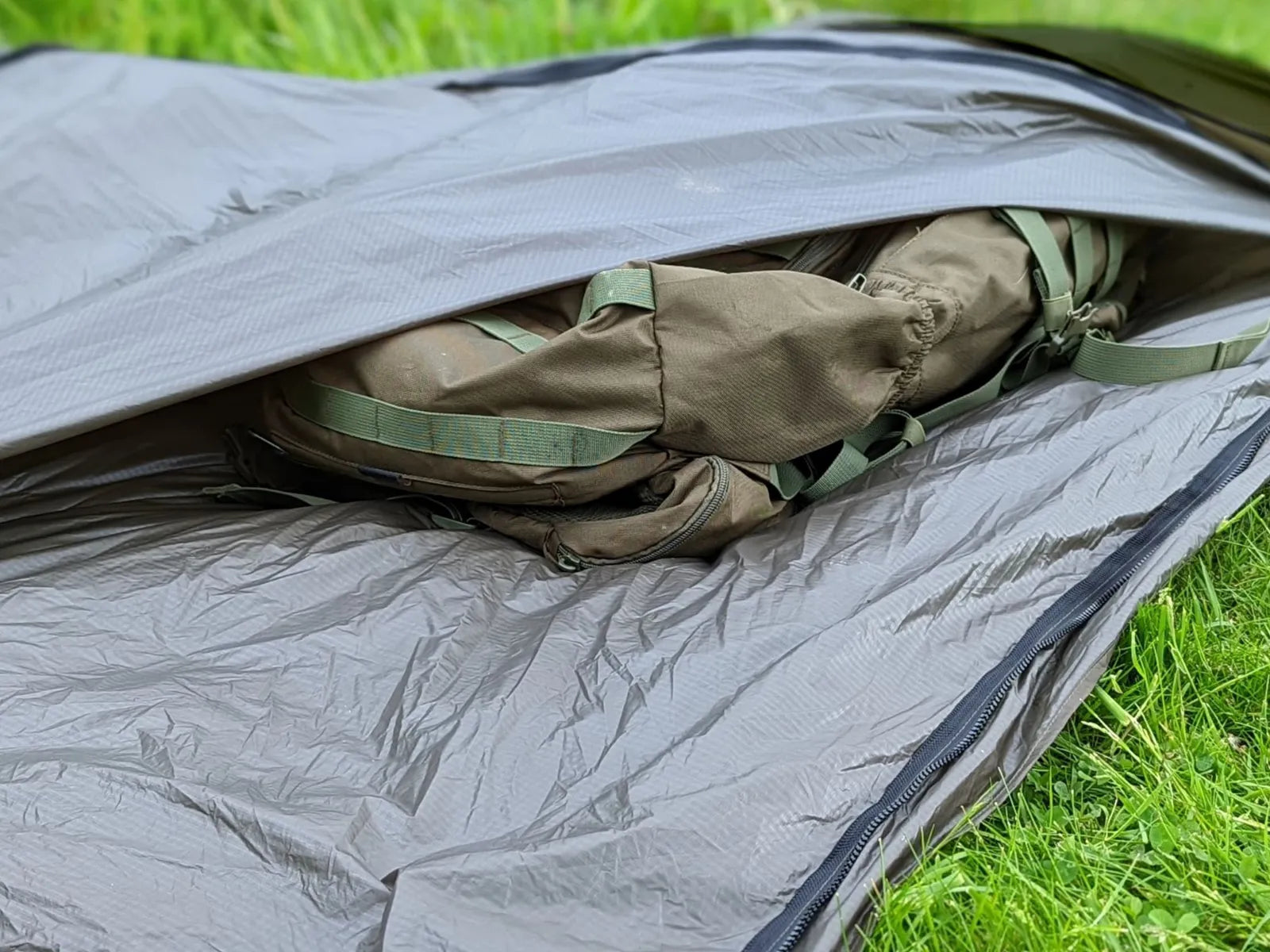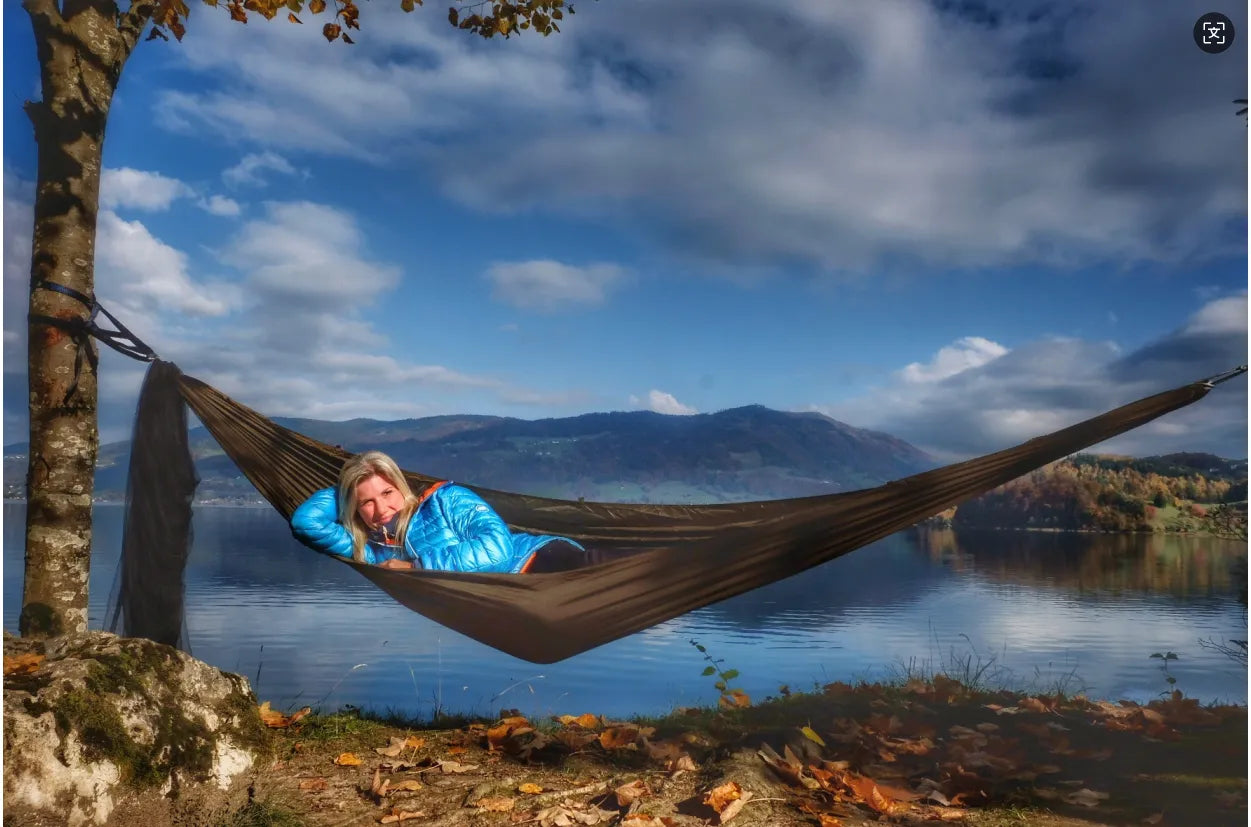Hamaca vs Tienda: El Enfrentamiento Definitivo al Aire Libre
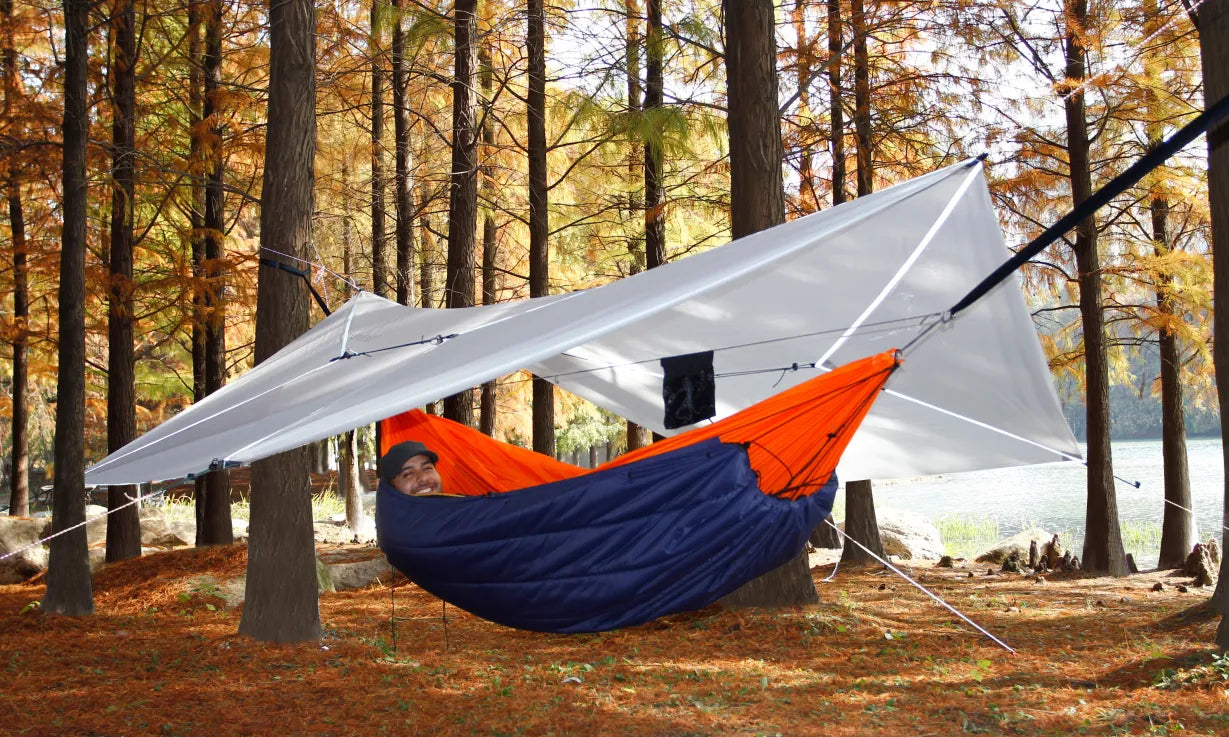
Decidir entre una hamaca o una tienda para tu próxima aventura puede parecer un verdadero enigma, ¿verdad?
A menudo nos encontramos en medio de un clásico enfrentamiento en escapadas al aire libre: hamaca vs tienda.
¿Quién gana el trofeo? Bueno, eso depende de un puñado de variables: comodidad personal, el clima que enfrentarás y cuánto equipo estás dispuesto a cargar.
But hold the phone! Before you pick one side, getting the lowdown on the pros and cons is essential.
In this extensive guide, we’ll pick apart everything from back support to storm preparedness so you can make an informed decision that aligns with your preferences.
Whether you’re a novice just dipping your toes in the wilderness or a seasoned backpacker who could pitch a tent in your sleep, there's plenty to glean here.
We’ll discuss critical aspects of hammock setups, such as finding the perfect trees—or telephone poles in a pinch—and tackle tent intricacies, like selecting the correct tent footprint or dealing with condensation.
Along the way, expect real talk about weight, cost, and convenience. Indeed, picking your ideal nighttime shelter can feel like a puzzle, but by the end of this piece, you’ll be confident about which route to choose.
Ready to swing into action? Let’s get down to brass tacks!
ON THIS PAGE
- Hammock Basics: A Cozy Swing
- Tent Essentials: The Classic Cocoon
- Weight & Portability: Cutting Ounces
- Comfort & Sleep Quality: Dreams in the Woods
- Weather Preparedness: Rain or Shine
- Site Selection: Finding the Perfect Spot
- Safety & Wildlife Encounters: Secure Snoozing
- Cost & Versatility: Getting the Biggest Bang for Your Buck
- Conclusion
- Hammock Basics: A Cozy Swing
- Tent Essentials: The Classic Cocoon
- Weight & Portability: Cutting Ounces
- Comfort & Sleep Quality: Dreams in the Woods
- Weather Preparedness: Rain or Shine
- Site Selection: Finding the Perfect Spot
- Safety & Wildlife Encounters: Secure Snoozing
- Cost & Versatility: Getting the Biggest Bang for Your Buck
- Conclusion
Hammock Basics: A Cozy Swing
Picture this: you’re gently swaying between two sturdy pines, gazing up at a canopy of stars, with a soft, cool breeze lulling you to sleep—sounds downright dreamy, doesn’t it?
Hammock camping has exploded in popularity in the outdoor community, and for all the right reasons.
Let’s dive into what hammock camping truly entails, explore the array of hammock types and accessories available, and highlight the many benefits that make it such an appealing choice for modern adventurers.
What Is Hammock Camping?
Hammock camping is all about strapping yourself into a lightweight, sling-like fabric—usually made from durable ripstop nylon—and suspending it between two natural anchor points (think trees, poles, or even specially designed supports).
In essence, you’re trading a traditional ground-based sleep system for one that lets you float above the earth, providing a unique, breezy, and often more comfortable sleep experience.
Key Features:
-
Lightweight & Compact: Hammocks pack down smaller than most tents.
-
Easy Setup: With just a couple of strong anchor points, you’re ready to go.
-
Natural Ventilation: Elevation off the ground helps avoid dampness and pests.
-
Versatility: Ideal for a range of climates when paired with the right accessories.
Types of Hammocks and Accessories
There’s a veritable smorgasbord of hammock options out there—each tailored to different camping styles and weather conditions. Here’s a quick rundown:
- Best for: Warm weather and summer adventures.
- Pros: Ultra-light, minimalistic, and perfect for quick trips.
- Cons: Not ideal for cold nights without additional insulation.
- Best for: Year-round use, especially in cooler conditions.
- Pros: Offers better insulation and durability.
- Cons: Slightly heavier, but worth the trade-off for added warmth.
c). Specialized Hammocks:
- Bottom Entry Hammocks: Easy access when climbing in and out.
- Zipper Hammocks: Provide a snug, enclosed feel, almost like a portable cocoon.
- Bridge Hammocks: Designed for shared use, perfect for couples or close friends.
Essential Accessories:
-
Underquilt: For insulation during chilly nights.
-
Top Quilt: Acts as an extra layer of warmth.
-
Mosquito Net: Keeps the bugs at bay without sacrificing airflow.
-
Rainfly: Offers full weather protection, creating a tent-like shelter when needed.

The Benefits of Hammock Camping
Hammock camping isn’t just a fad—it offers real, tangible benefits that can elevate your outdoor experience:
a). Rapid Setup:
- Simply locate two robust anchor points, secure the straps at the right height, and—bam!—you have your overnight bed ready in minutes.
b). Enhanced Comfort:
- Many campers swear by the natural spinal support provided by a hammock’s gentle curve, making it a boon for both side-sleepers and back-sleepers.
c). Elevated Safety:
- Being off the ground means you’re less likely to deal with moisture, uneven surfaces, or critters creeping into your sleeping bag.
d). Lightweight & Portable:
- Hammocks typically weigh less than traditional tents and can be packed down to a fraction of the size, making them ideal for backpacking and ultralight adventures.
e). Versatility:
- With the right combination of accessories, a hammock can be adapted for a variety of conditions—from sweltering summer nights to brisk winter camping.
Some Considerations to Keep in Mind
Of course, nothing’s perfect, right? Here are a few caveats:
a). Cold Weather Challenges:
- Dangling above the ground in sub-freezing temperatures can be a recipe for discomfort unless you invest in specialized insulation like underquilts and top quilts.
b). Site Limitations:
- If you’re camping in a desert plateau or any area lacking robust natural anchor points, setting up a hammock can be a real head-scratcher.
c). Plan & Prepare:
- With a bit of ingenuity and pre-planning, these obstacles are surmountable. The market is awash with diverse models that cater to every need, from single-layer options for warm weather to heavy-duty double layers for winter insulation.
| Feature | Hammock Camping | Traditional Tent Camping |
|---|---|---|
| Setup Time | Minimal; quick if trees are available | Longer; requires a flat, clear space |
| Weight | Ultra-light; packs down compactly | Generally heavier, even in ultralight models |
| Comfort | Natural spinal support with a gentle curve | Stable surface but depends on ground quality |
| Weather Adaptability | Excellent with proper accessories (rainfly, underquilt) | Enclosed protection; may get stuffy |
| Terrain Requirements | Best in wooded areas; not ideal in treeless zones | Can be pitched almost anywhere |
Is Hammock Camping Right for You?
So, is the hammock camp life calling your name?
It might just be the perfect solution if you crave rapid setup, exceptional comfort, and the thrill of sleeping aloft—provided Mother Nature lends you the right trees and conditions.
While challenges like cold weather or sparse vegetation may throw a wrench in the works, with a little planning, you can turn those potential pitfalls into mere speed bumps on your outdoor journey.
In a nutshell, hammock camping offers a lightweight, portable, and uniquely comfortable alternative to traditional tents.
Ready to embrace the sway and see for yourself if this laid-back style of camping ticks all your boxes?
What’s holding you back from giving hammock camping a try?
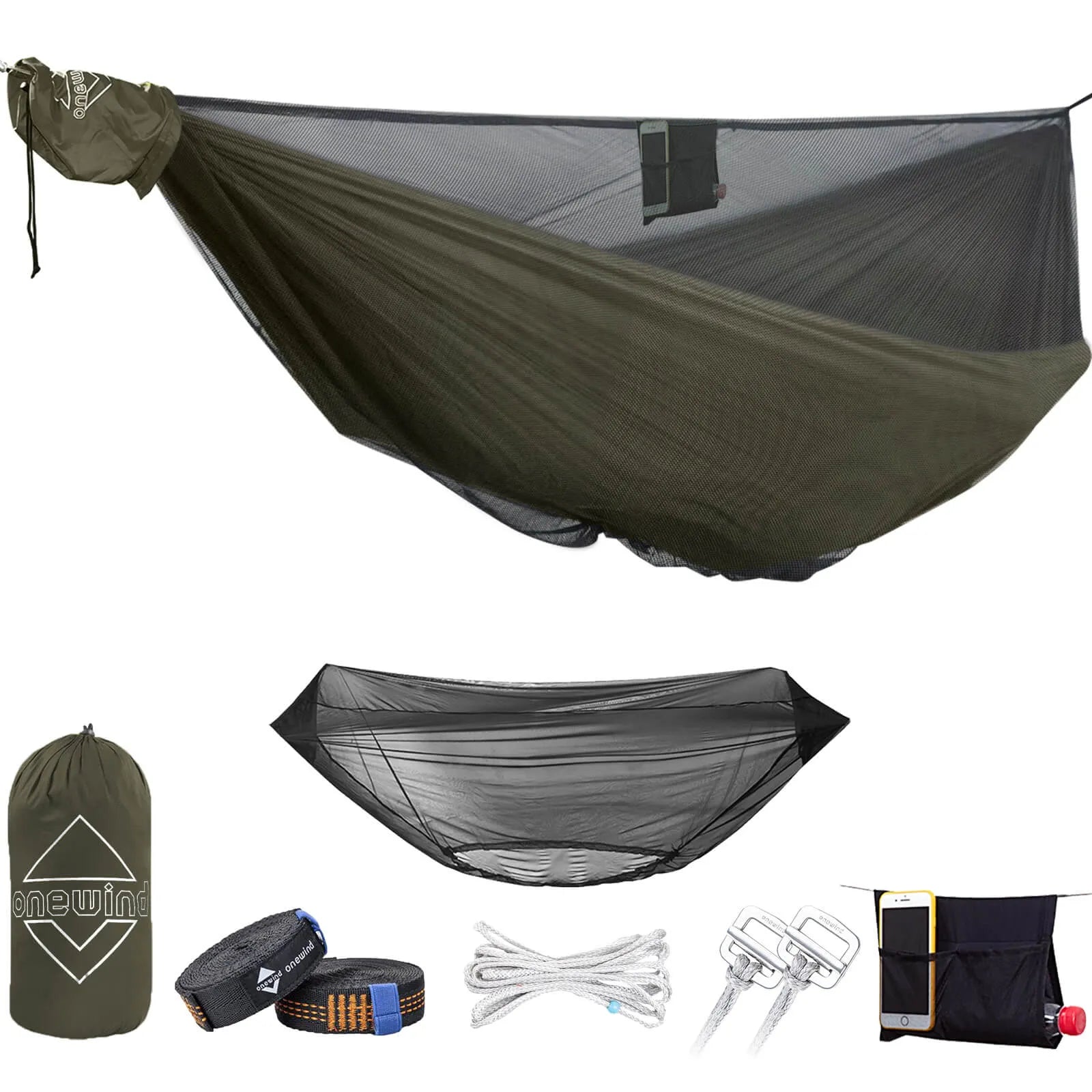
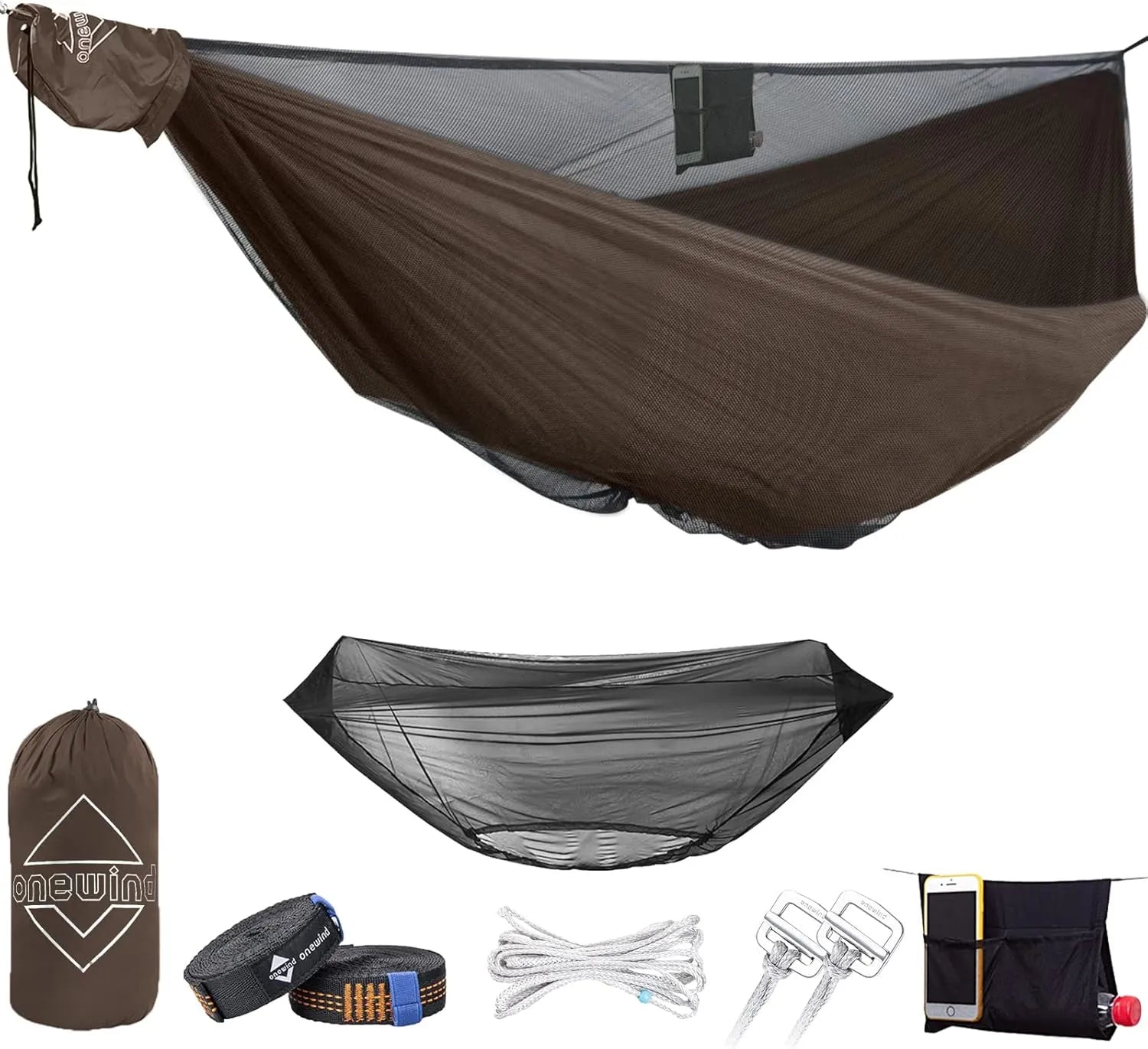

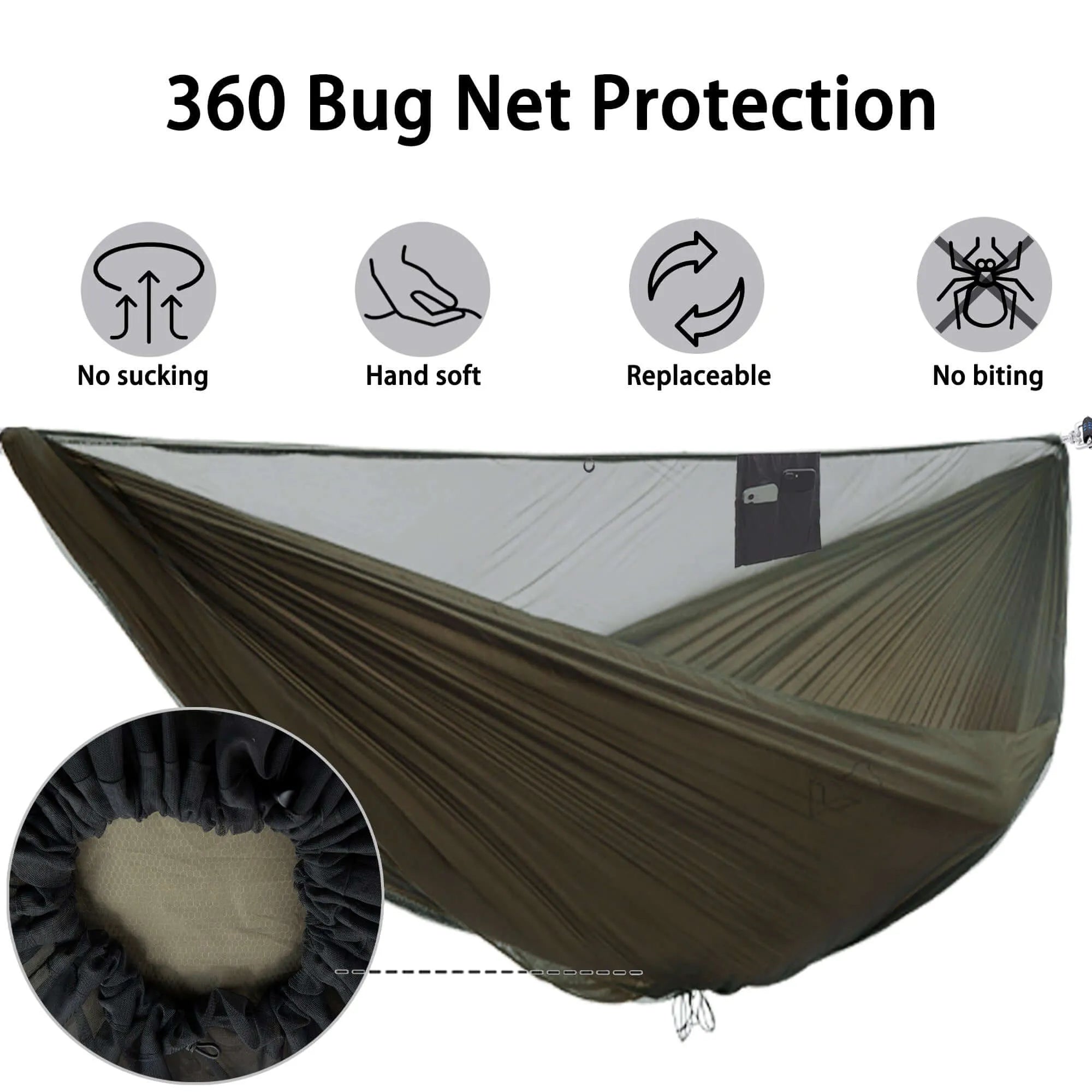
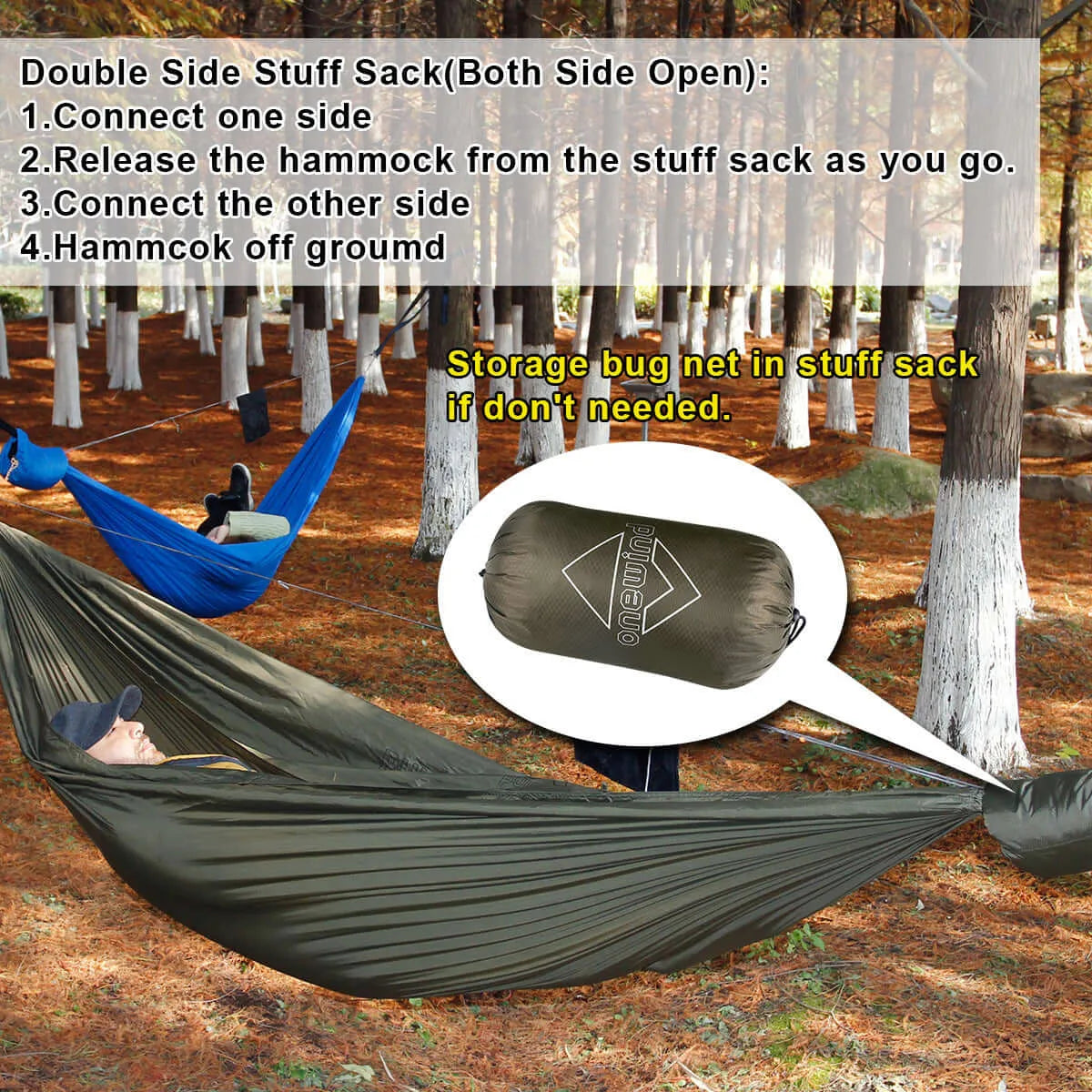
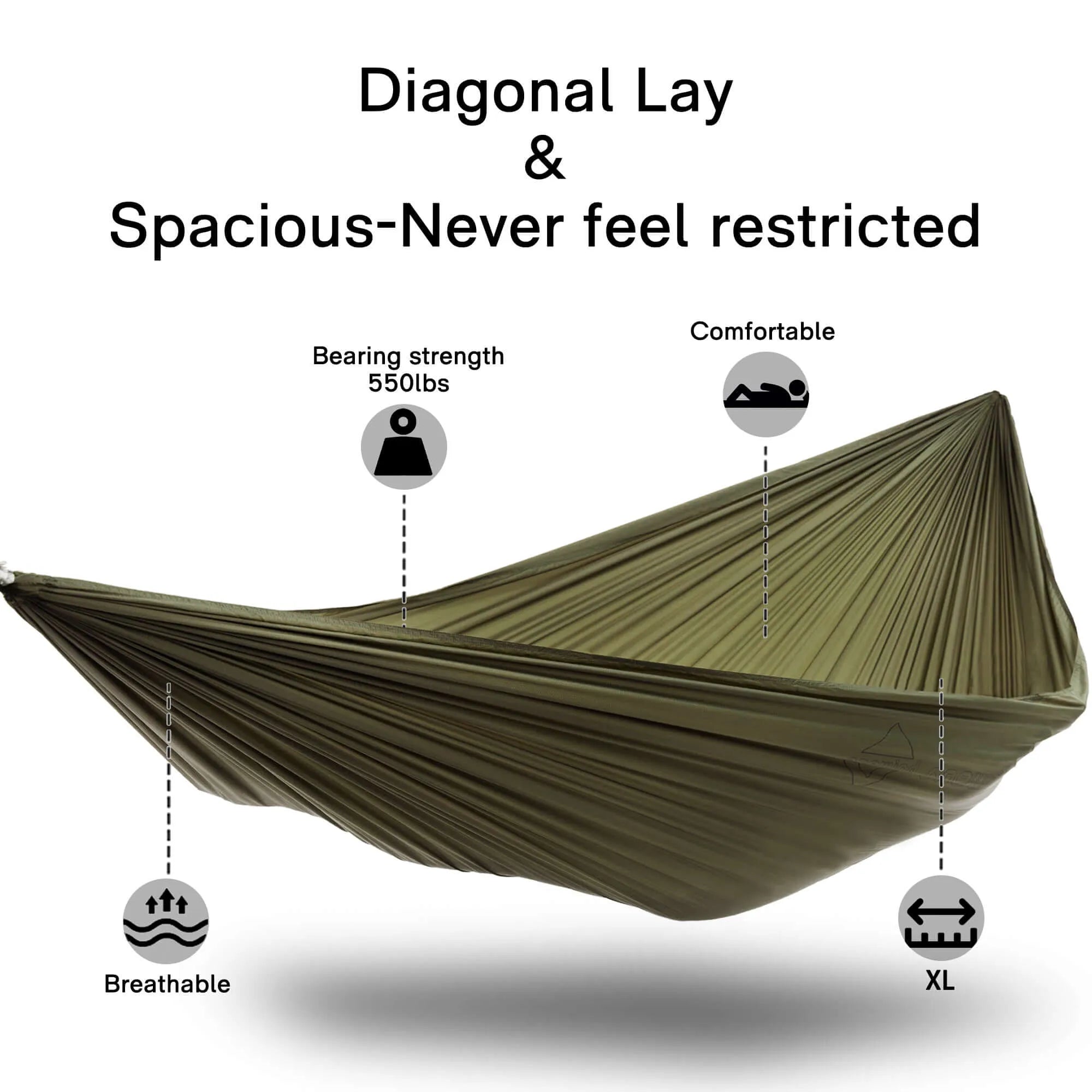
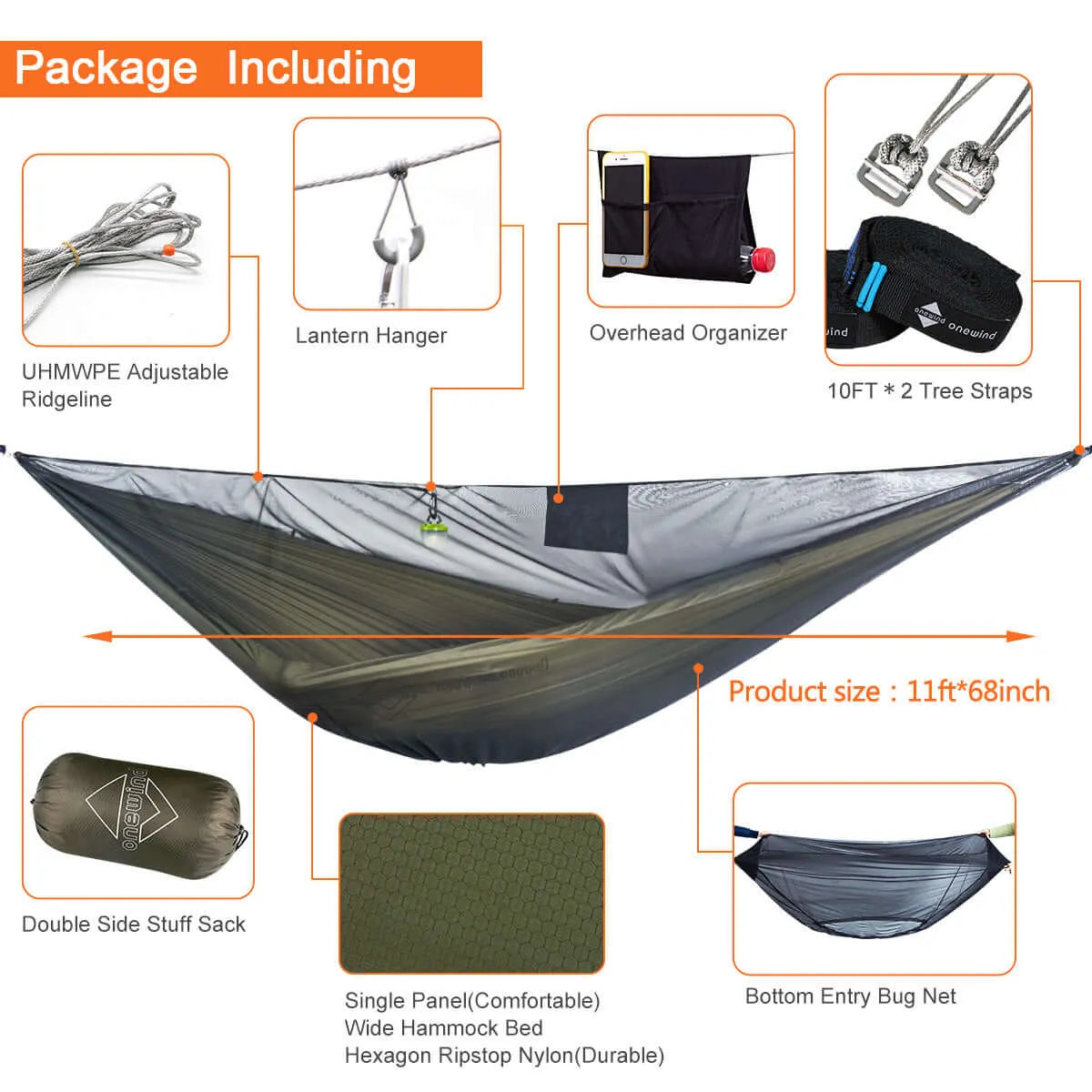
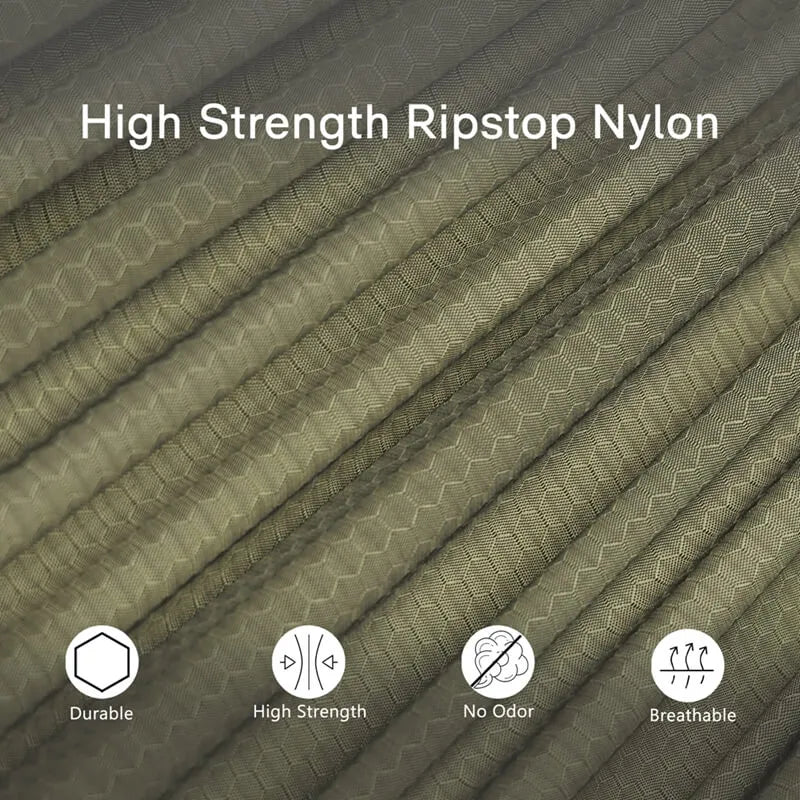


Onewind® Outdoors
Hamaca de Camping Doble Aerie de 11' con Red Antimosquitos
Acerca del Artículo
- Diseño Espacioso y Cómodo: Con 11' x 68", esta hamaca de camping extra larga y ancha garantiza una comodidad superior con una posición diagonal plana, eliminando la incómoda curva en forma de plátano común en hamacas más cortas. Perfecta para una relajación al aire libre reparadora.
- Duradera y Ligera: Fabricada con nylon ripstop hexagonal 70D de 2.1oz, esta hamaca es resistente a la abrasión, transpirable y extremadamente fuerte, soportando hasta 500 lbs mientras pesa solo 2.64 lbs, lo que la hace ideal para mochileros ultraligeros y senderismo.
- Protección Integrada contra Insectos: La red para insectos de entrada inferior desmontable sella completamente para proteger contra mosquitos e insectos. Su sistema de cordón elástico previene enganches en la tela, y el diseño reemplazable asegura funcionalidad a largo plazo para aventuras al aire libre.
- Sistema de Suspensión Completo Incluido: Viene con correas ajustables para árboles de 12', hebillas de ajuste y una línea de cresta para una configuración y personalización sin esfuerzo. La línea de cresta permite ajustar la caída para una comodidad óptima, y todos los componentes se almacenan de manera compacta en el saco de almacenamiento de doble cara.
- Características Premium para Aventuras al Aire Libre: Diseñada para la versatilidad, esta hamaca es perfecta para acampar, hacer senderismo o mochilear. Sus materiales resistentes a la intemperie, construcción ligera y diseño pensado proporcionan una experiencia de sueño al aire libre inigualable.
Tent Essentials: The Classic Cocoon
Now, let’s pivot to tents—the trusty cocoon of the camping world. For ages (or at least since our grandparents’ day), tents have been the go-to shelter for those seeking refuge in the wild.
They offer a snug, enclosed space that fends off everything from icy winds and heavy snow to torrential downpours.
Whether you’re an ultralight backpacker on a mission to shave off a few precious ounces or a family of four in need of ample space, there’s a tent variation that’s just right for you.
Tent Components & Variations
Modern tents come in a dazzling array of shapes and sizes, each tailored to specific camping styles and environments. Let’s break it down:
- Who they’re for: Solo adventurers and minimalist hikers.
- Features: Feather-light materials, compact pack size, and quick setup.
b). Four-Season Tents:
- Who they’re for: Hardcore mountaineers and winter warriors.
- Features: Reinforced structures, wind-resistant frames, and robust fabric to battle snow and ice.
c). Family or Cabin Tents:
- Who they’re for: Car campers and families looking for extra room.
- Features: Spacious interiors, multiple rooms or vestibules, and plenty of gear storage.
d). Modular or Convertible Tents:
- Who they’re for: Those who need versatility on the fly.
- Features: Adaptable designs that can switch from an open shelter to a fully enclosed space with a rainfly.
Weather-Resistant Features
One of the tent’s major selling points is its ability to stand up to the elements. Here’s what you typically find in a modern tent:
a). Waterproof Rainfly:
- Often rated at 1500–3000+ mm hydrostatic head, it ensures you stay dry even in heavy rain.
b). Breathable Mesh Panels:
- These promote airflow to keep condensation at bay while maintaining privacy.
c). Durable, Sealed Floor:
- Designed to keep moisture from seeping in, ensuring your sleeping area remains dry and comfortable.
d). Reinforced Poles & Stitching:
- For extra wind resistance and long-term durability in rugged conditions.
Quick Pros & Cons Snapshot
Let’s break down the advantages and disadvantages in a quick bullet list:
Pros:
a). Superior Weather Protection:
- Tents offer robust shelter against harsh weather conditions.
b). Private, Enclosed Space:
- Enjoy the comfort and security of an enclosed environment.
c). Versatility Across Terrains:
- Can be pitched on flat ground almost anywhere—no trees required!
d). Extra Storage:
- Plenty of room to stow gear inside, away from the elements.
Cons:
a). Weight & Bulk:
- Typically heavier than hammock setups, which can be a drawback for ultralight backpackers.
b). Need for Flat Ground:
- Requires a level, debris-free area for proper pitching, which isn’t always available.
c). Potential for Stuffiness:
- In hot weather, the enclosed space can feel like a sauna—albeit with a zipper door!
| Feature | Tent Camping | Hammock Camping |
|---|---|---|
| Setup Time | Moderate; requires staking and pole assembly | Very quick; find two trees and hang it |
| Weight | Generally heavier, especially for 4-season models | Ultra-light, minimal gear required |
| Weather Protection | Enclosed, excellent for extreme conditions | Needs additional accessories (rainfly, underquilt) |
| Terrain Flexibility | Can be pitched on flat, cleared ground | Limited to areas with natural anchors (trees) |
In Conclusion
Tents have earned their reputation as the classic camping cocoon for a reason.
They offer unparalleled protection and an enclosed haven to store your gear, making them ideal for a variety of camping scenarios—from backpacking to car camping.
Yet, they’re not without their quirks; the extra weight and need for a flat setup spot might not suit every adventurer’s style.
So, as you weigh your options between the nimble hammock and the sturdy tent, ask yourself: does the promise of a private, weatherproof retreat outweigh the convenience of a lightweight, nature-hugging sleep?
Ready to decide which shelter best fits your next adventure?



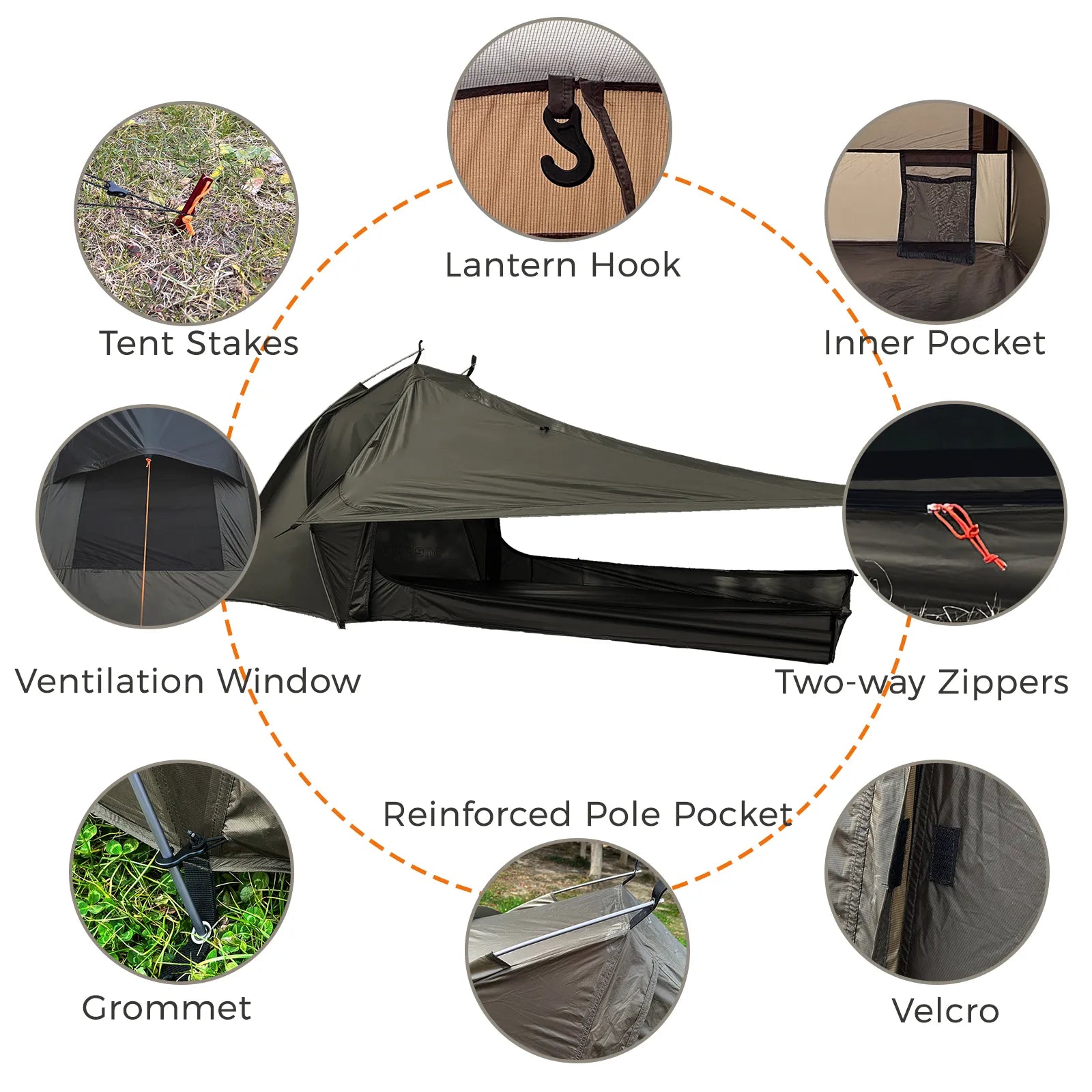

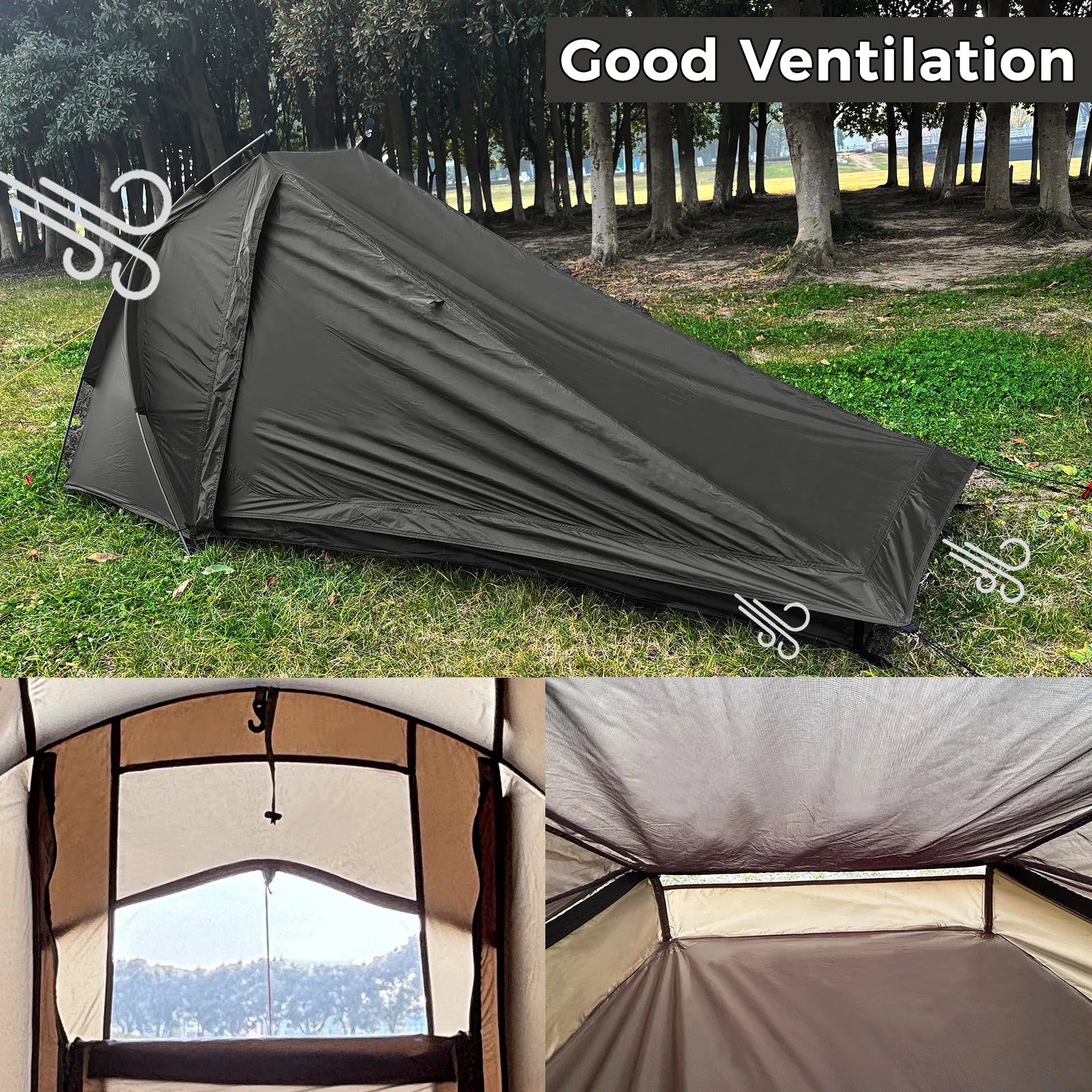
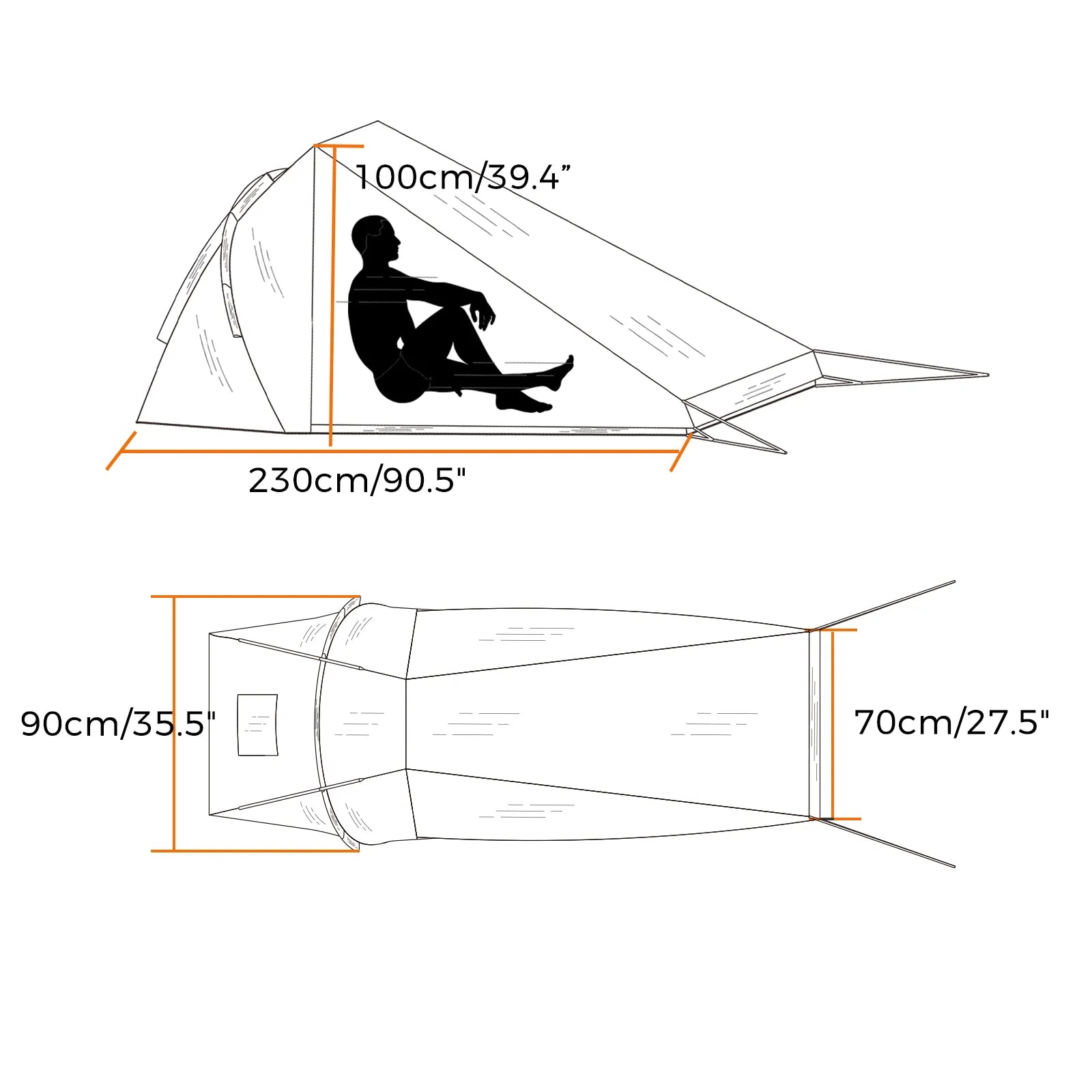
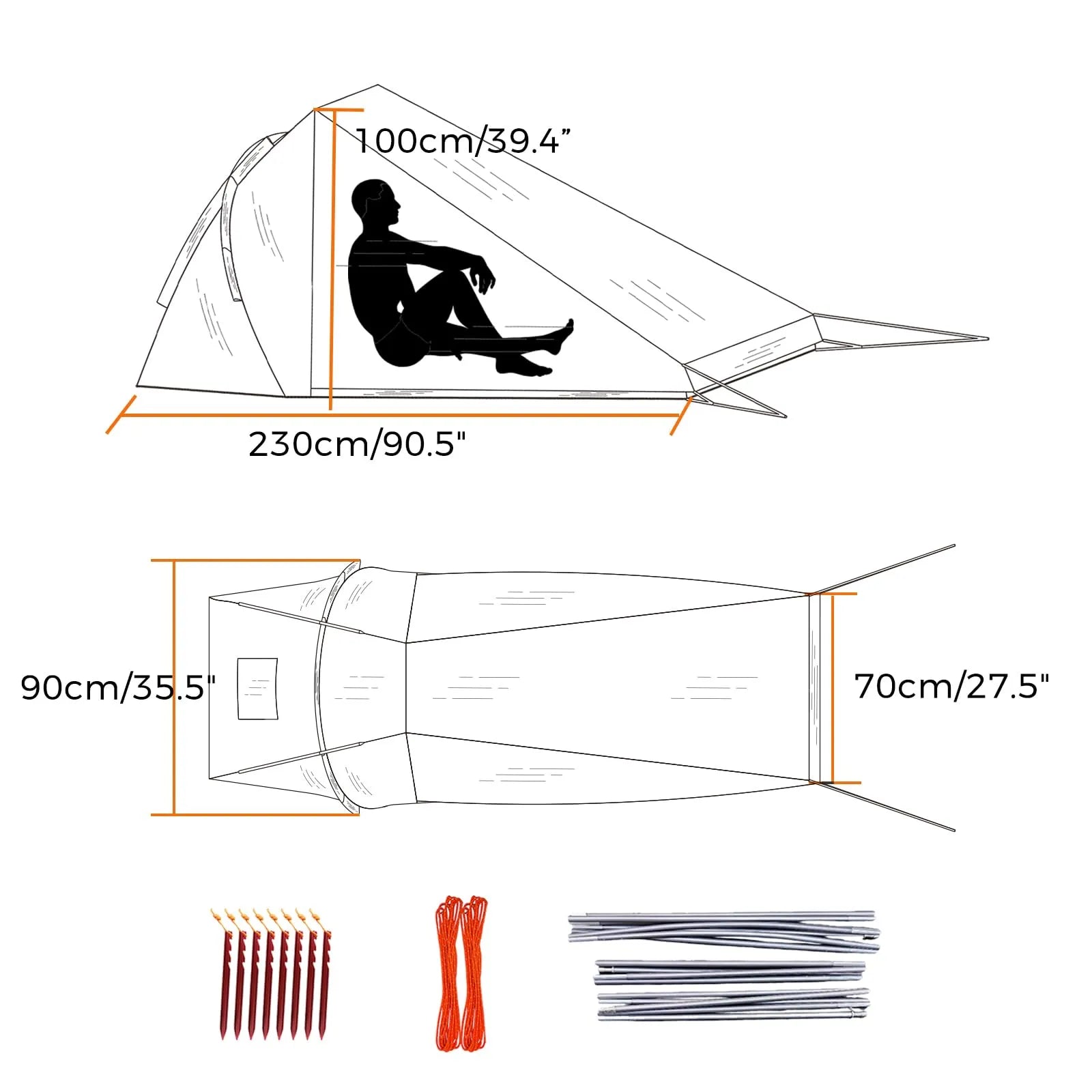
Onewind® Outdoors
Solo Skyshade Tartent
Acerca del Artículo
- Diseño Ultraligero y Duradero: Fabricado con tela de 1.1oz 20D Silnylon Ripstop de primera calidad, esta tienda ofrece una excepcional protección impermeable (3000mm) y durabilidad. Su construcción ligera asegura una fácil portabilidad, pesando solo 2.6 lbs, lo que la hace perfecta para mochileros, senderismo y aventuras en solitario.
- Versatilidad Multifuncional: Diseñada para uso en 3 estaciones (Primavera, Verano, Otoño), esta tienda se puede montar en múltiples configuraciones: completamente cerrada para privacidad, solo con la cubierta para sombra, o en modo solo malla para ventilación. Adáptate a diversas condiciones con facilidad, ya sea el calor del verano o las lluvias de otoño.
- Confort y Espacio Excepcionales: Con dimensiones de 90.5" x 35.5" x 39.4", el Solo Skyshade ofrece amplio espacio para dormir cómodamente y sentarse erguido, a diferencia de las tiendas bivy tradicionales. Su interior espacioso y su efectivo sistema de ventilación aseguran un ambiente acogedor y transpirable.
- Montaje Rápido y Sencillo: Con un diseño de 3 postes y simples puntos de sujeción, esta tienda está lista en minutos. Los postes de aluminio incluidos, las cuerdas reflectantes y las estacas en forma de Y aseguran un montaje sin complicaciones y una estabilidad confiable en diversos terrenos.
- Características Pensadas para Entusiastas del Aire Libre: Equipado con dos puertas, ventanas de ventilación a prueba de lluvia y cabezales de cremallera codificados por colores, esta tienda proporciona conveniencia y practicidad. Su acceso con cremallera de doble cara y múltiples opciones de ventilación mejoran la comodidad y la usabilidad para campistas solitarios.
Weight & Portability: Cutting Ounces
Regarding backpacking, every ounce truly counts—nobody wants to haul an extra pound up a mountain when you’re panting like a dog in the blazing summer sun, right?
Let’s break it down and see how hammock versus tent solutions stack up in weight and portability so you can keep that load light and your adventure smooth sailing.

Comparing the Basics
a). Hammock Setup:
A typical hammock kit—comprising the hammock, suspension straps, a tarp, and a bug net—usually weighs about 2 to 3 pounds.
If you're gearing up for colder weather, you might add an underquilt to keep warm, which can add another 1 or 2 pounds.
- Key Perks: Minimal bulk, compact packability, and effortless setup in the right conditions.
b). Tent Setup:
Ultralight tents can be as featherweight as 2 pounds, but most standard backpacking tents hover closer to 3 to 5 pounds.
And don’t forget—you’ll also likely be lugging along a sleeping pad and possibly a footprint or groundsheet to protect the floor.
- Key Perks: Versatile placement (no trees required) and the all-around comfort of an enclosed shelter.
Additional Accessories: The Fine Print
Here’s a bit of extra info to keep in mind:
a). Hammock Accessories:
- Underquilt: Adds insulation in cold conditions but bumps up the weight.
- Extra Tarp or Bug Net: Optional add-ons might be necessary depending on weather or critter concerns.
b). Tent Accessories:
- Footprint/Groundsheet: Offers extra protection for your tent floor.
- Extra Stakes and Guylines: Handy for stability, especially in windy conditions.
- Sleeping Pad: Not just for comfort; it’s a crucial element of insulation from the ground.
| Gear Setup | Approx. Weight (lbs) | Comments |
|---|---|---|
| Hammock Kit | 2 - 3 | Includes hammock, straps, tarp, and bug net |
| Tent Kit | 3 - 5 | Includes tent body, poles, stakes, and rainfly |
Note: Add an under quilt (1-2 lbs) to your hammock setup for chilly nights, and factor in a sleeping pad (typically 1-2 kg) with your tent.
The Bottom Line
Holy smokes, that’s a lot to mull over! If you’re an ultralight fanatic, a hammock might be more appealing—especially if you can skip the under quilt on mild summer nights.
However, some top-of-the-line ultralight tents can rival hammock setups in weight, so it’s not always black and white.
Remember, hammocks typically pack down to a fraction of the size of tents, but if you’re trekking into an alpine zone with limited tree cover, you might find yourself lugging a hammock for no good reason.
Ultimately, your comfort threshold and the environment you’re trekking through will dictate your best choice.
So, before you commit, why not weigh (pun intended) your options carefully and even do a little test run in your backyard or at a local campground?
Are you ready to cut those extra ounces and pick the perfect setup for your next adventure?
Comfort & Sleep Quality: Dreams in the Woods
Now, let’s dish on the one aspect that can make or break a camping trip—a killer night’s sleep!
When you’re out in the sticks, being well-rested can be the difference between having an epic adventure and wanting to hitchhike home ASAP.
So, how do hammock and tent setups stack up in the slumber department?
The Hammock Sleep Experience
Imagine this: you're cradled in a hammock that molds to your body’s contours, relieving pressure points as if they were custom-made.
Here’s what makes hammock sleep so darn appealing:
a). Ergonomic Support:
- The fabric gently conforms to your curves, reducing those pesky pressure points.
- Its natural, slightly curved shape can help align your spine—pretty neat, right?
b). Soothing Motion:
- The gentle, rhythmic rocking is like a lullaby, lulling you into a deep sleep, almost like a parent rocking you.
- That soft sway might help you drift off faster on those long, starry nights.
c). Elevated Comfort:
- Being off the ground means no more cold, damp floors or uneven surfaces that leave you tossing and turning.
- Plus, you get an unobstructed view of the heavens—talk about a natural nightlight!
Heads-up: Without a proper under quilt or top quilt, you might end up with what campers affectionately call "cold butt syndrome" when the breeze picks up.
But hey, that’s an easy fix with some extra insulation.

The Tent Sleep Experience
Tents, on the other hand, offer a whole different ballgame. They give you a solid, enclosed space that’s perfect if you like a bit of room to sprawl out. Let’s break it down:
a). Room to Sprawl:
- Whether tossing, turning, or even sleeping diagonally (if you’re feeling adventurous), tents provide ample space for your nighttime acrobatics.
- A proper sleeping pad adds a layer of cushioning, which can be a game changer if you’re not a fan of rocky, lumpy ground.
b). Temperature & Ventilation Control:
- Many modern tents have adjustable vents, so you can keep the airflow just right—cool when it’s hot and insulated when it’s chilly.
- However, being cooped up in sweltering heat might feel like a makeshift sauna (zipper door and all).
c). Noise & Privacy:
- The enclosed structure of a tent creates a psychological buffer from the outside world.
- It mutes the ambient sounds—a rustling leaf here, a hooting owl there—which can be a blessing if you prefer a quieter sleep.

Quick Comparison: Hammock vs. Tent Sleep
To put it all in perspective, here’s a handy table that contrasts the key comfort factors:
| Aspect | Hammock Sleep | Tent Sleep |
|---|---|---|
| Posture | Naturally conforms; gentle rocking can be soothing | Offers room to sprawl; relies on a good sleeping pad for comfort |
| Temperature | Needs extra insulation in cold conditions; breezy outdoors can be refreshing or chilly without gear | Adjustable vents help regulate temperature; risk of stuffiness in heat |
| Noise Exposure | Exposes you to natural sounds—can be enchanting or jarring | Enclosed space dampens external noise, providing privacy |
| Setup Flexibility | Quick setup in wooded areas; limited in open landscapes | It can be pitched on flat ground almost anywhere; it requires a level surface |
In Conclusion
Both hammock and tent setups come with their own set of pros and quirks.
A hammock might just be your cup of tea if you’re all about that floating, airy sensation under a canvas of stars—and don’t mind the extra step of insulating your setup.
Conversely, a tent could be your ideal choice if you’re a side sleeper who needs a solid, stable base with extra room for gear.
Ultimately, the choice boils down to your preference, your body’s needs, and the specific camping conditions you expect.
So, after weighing the posture perks, temperature tweaks, and noise nuances, which sleeping setup tickles your fancy the most?
Are you ready to choose between a hammock's gentle cradle and a tent's cozy enclosure?
Weather Preparedness: Rain or Shine
Alright, folks—when it comes to braving the wild, Mother Nature never plays by the rules.
Sooner or later, she’ll toss you a curveball: a torrential downpour one minute and a bone-chilling cold snap the next.
Now, the burning question is—how do hammock and tent setups stack up against the whims of the weather?
Hammock in Rain: Stay Dry Without the Drip
Picture this: you're suspended high above a soggy ground, sheltered under a well-rigged tarp.
With your hammock set up correctly, you’ll stay dry, but there’s a catch—water can sneak its way down those suspension straps if you’re not careful. Here’s the lowdown:
Key Gear & Tips:
-
Tarp: A sturdy, waterproof tarp is your best friend; ensure it’s securely fastened.
-
Drip Lines & Carabiners: Essential to channel away any sneaky water droplets from the straps.
-
Pro Tip: Always pitch the tarp first to create a dry zone underneath your hammock. This small step can be a total game-changer when the skies open up.
Additional Consideration:
-
If you expect heavy rain, consider extra tie-outs to ensure the tarp stays taut and the water doesn’t pool.
Tent in Rain: Your Dry Fortress
Tents, that classic camping staple, often come with various weather-resistant features.
A decent tent typically sports a waterproof rating of 1,500 to 3,000 mm hydrostatic head and a robust rainfly to keep you bone-dry. But remember:
Setup Caveat:
- Pitching your tent in a low-lying area might inadvertently invite a mini-flood—so always scout for higher ground.
Extra Protection:
- A tent footprint is a nifty addition that prevents ground moisture from creeping in, safeguarding your tent floor.
Quick Checklist for Rainy Setup:
- Stakes and Guylines: Secure every corner to keep the rainfly from flapping.
- Proper Ground: Find an elevated spot free from water runoff.
- Footprint: Lay one down to add an extra layer of defense against dampness.

When the Mercury Drops: Cold Nights and Insulation
Now, what happens when the temperature plummets overnight? In a hammock, your secret weapon is insulation. Here’s what you need to know:
Hammock Insulation:
-
Under Quilt: Acts as a thermal barrier beneath you—crucial for keeping that chill at bay.
-
Sleeping Pad: A well-secured pad can provide additional insulation and comfort.
-
Remember: Without proper insulation, you might end up with a case of “cold butt syndrome”—a not-so-fun scenario on a frosty night.
Tent Insulation:
-
Microclimate Advantage: A tent naturally traps some of your body heat, creating a snug little microclimate.
-
Gear to Consider: Even so, you’ll still want a robust sleeping bag and an insulating pad to ensure you don’t wake up shivering.

Battling the Wind: Swaying vs. Staking
Wind, oh wind—nature’s relentless force that can either be a soothing lullaby or a terrifying tempest.
Hammock Dynamics:
-
Sway Factor: Hammocks inherently sway with the wind. Some campers love that gentle rocking motion; others don't.
-
Stability Tip: Secure your suspension points properly to minimize excessive movement, especially on gusty nights.
Tent Stability:
-
Proper Staking is Key: A tent not staked down properly can flatten out in gale-force conditions.
-
Wind Blockers: Many tents now come with additional guy lines or even wind-blocking features to keep your shelter standing tall.
General Weather Prep:
-
Always Check the Forecast: Don’t leave home without peeking at the weather report.
-
Carry the Right Gear: Whether you’re team hammock or team tent, ensure you have a well-maintained tarp, under quilt, or rainfly ready.
Quick Comparison Table
| Aspect | Hammock Setup | Tent Setup |
|---|---|---|
| Rain Protection | Requires a well-rigged tarp; watch for water seepage on straps | Waterproof rainfly and footprint keep you dry if pitched correctly |
| Cold Weather | Depends on additional insulation (under quilt, pad) | Traps some body heat but still needs a robust sleeping bag and pad |
| Wind Resistance | Sways naturally; stability relies on secure suspension | Can flatten out if not properly staked; extra guylines help |
| Ease of Setup | Quick in wooded areas; challenging in treeless zones | Versatile; requires flat, clear ground for optimal performance |
Prepare, Practice, and Prevail
If you prepare accordingly, both hammock and tent setups can withstand Mother Nature’s worst.
Whether it’s the art of pitching a tarp over your hammock or staking down your tent on a windy day, attention to detail is key.
User error, however, can unravel even the best-laid plans, so practice your pitching skills for a hammock or a tent so you’re never caught off guard in the boonies.
So, after weighing all these factors—rain, cold snaps, wind, and the essential gear needed—what’s your game plan when the weather throws you a curveball?
Ready to face the elements head-on and choose the setup that best suits your adventure needs?
Site Selection: Finding the Perfect Spot
Have you ever spent half an hour hunting for that elusive, ideal spot to pitch your tent, only to end up on an ant hill or a slope that sends you rolling downhill at 2 a.m.?
Talk about a recipe for disaster! When comparing hammock vs. tent setups, site selection is where the rubber truly meets the road.
So, let’s break it down, weigh your options, and get savvy about where to set up camp.
Different Site Requirements: Hammocks vs. Tents
a). Hammock Setups:
Hammocks demand a particular site—one where nature lends a helping hand. Here’s what you need to keep in mind:
Anchor Points Are Key:
-
Two Robust Trees: To securely hang your hammock, you’ll need two sturdy trees, ideally with trunks about 12 to 15 feet apart.
-
No Overhead Hazards: Look out for dead branches or “widowmakers” that could fall in a stiff breeze.
Tree-Friendly Gear:
-
Strap It Right: Using tree-friendly straps (at least 1 inch wide) is crucial to prevent bark damage while staying true to Leave No Trace ethics.
Flexible Ground Requirements:
- Not Too Fussy About the Floor: Since you’re elevated, the ground can be uneven, rocky, or even infested with insects without affecting your sleep quality.
b). Tent Setups:
Tents, by contrast, offer more flexibility when it comes to site conditions—but they have their own set of demands:
Flat, Debris-Free Ground:
- The level is Lovely: A flat, transparent surface is a must because nobody wants a sharp rock to wake them up at night.
- Watch Your Step: Ensure the area is free of debris that could puncture your sleeping pad or tent floor.
Water Flow Considerations:
-
Avoid Low Spots: Pitching a tent in a drainage area or low-lying spot risks a mini-flood, so scout higher ground.
Established Sites Are Golden:
-
Stick to the Trails: When possible, choose established campsites to minimize your environmental impact and adhere to Leave No Trace principles.

The Environmental Angle: Leave No Trace Ethics
Being an eco-friendly camper is non-negotiable these days. Both hammock and tent campers should aim to tread lightly on nature.
Here’s how you can keep your footprint minimal:
Hammock Campers Should:
- Use Tree-Friendly Straps: Prevent damage to tree bark by opting for wide, padded straps.
- Select Natural, Undisturbed Spots: Avoid areas where your setup might disturb local flora or fauna.
Tent Campers Should:
-
Pitch in Established Sites: This minimizes your impact on delicate ecosystems.
-
Clear Debris Carefully: Remove only necessary, and always follow Leave No Trace guidelines.

A real-life example: one seasoned backpacker recalled spending hours searching for a level spot only to find that the ideal site was a well-trodden clearing near a trailhead—proving that sometimes the best choice is the one already set aside for campers, leaving nature undisturbed.
Quick Comparison Table
| Aspect | Hammock Setup | Tent Setup |
|---|---|---|
| Site Requirements | Needs two sturdy trees (12–15 ft apart) | Requires a level, debris-free ground |
| Flexibility | More adaptable to uneven terrain; no need for flat ground | Demands flat, open space |
| Environmental Impact | Minimal impact if using tree-friendly straps | Lower impact on flora when using established campsites |
| Challenges | Limited to wooded areas; tree availability is key | Risk of flooding in low spots; must watch for sharp objects |
In Conclusion, Choose Wisely and Tread Lightly
So, what’s the final word on site selection?
Simply put, your choice between a hammock and a tent will ultimately depend on the natural resources available at your campsite and your commitment to environmental stewardship.
Hammocks shine in wooded areas where natural anchor points abound, while tents offer versatility in open fields but require a good, level spot and a little extra caution.
Remember, being a responsible camper means seeking out the best spot for your comfort and ensuring you leave nature just as pristine—or even better—than you found it.
So, after weighing all these factors, which setup aligns with your camping style and environmental values? Are you ready to pick your perfect spot and camp with confidence?
Safety & Wildlife Encounters: Secure Snoozing
Ever wake up face-to-face with a raccoon rummaging through your pack? That’s the stuff of nightmares!
Safety is paramount when it comes to roughing it in the great outdoors, and both hammock and tent setups come with their pros—and cons.
Let’s break it down, weigh the risks, and arm you with some quick safety tips so you can sleep soundly, knowing you’re prepared for whatever the wild throws.
Common Safety Concerns
Camping isn’t all marshmallow s'mores and starry nights; you’ve got to be mindful of various hazards, including:
Wildlife Intrusions:
-
Unwanted visitors like raccoons, bears, and even sneaky snakes.
Insect Intrusions:
-
Mosquitoes, gnats, and other critters can quickly turn your sleep into a scratch-fest.
Falling Branches:
- Those dreaded “widowmakers” that might drop when the wind picks up.
Environmental Hazards:
- Uneven ground, unexpected puddles, or even a sudden temperature change.
Comparing Risk Factors: Hammock vs. Tent
a). Hammock Safety Considerations:
Elevation Advantage:
- Being suspended above the ground means many small critters (like snakes and spiders) are less likely to invade your space.
Open Exposure:
- On the flip side, hammocks can leave you feeling a bit exposed. For example, if a bear ambles by, there’s no solid barrier—just a thin layer of nylon that might not discourage a determined animal.
Bug Nets:
- Most quality hammock systems now come with integrated bug nets, which, if fitted snugly, can keep the bloodsuckers at bay.
b). Tent Safety Considerations:
Enclosed Security:
- Thanks to mesh screens and sealed zippers, tents offer a fortified, enclosed space like Fort Knox for bugs and critters.
Ground Vulnerabilities:
- However, you’re subject to what’s underfoot—uneven terrain, potential water seepage, or even critters that might burrow in the ground.
Structural Limitations:
- Improper staking or setting up on a slope can compromise a tent’s stability, especially when heavy winds roll in.

Quick Safety Tips to Keep You Secure
No matter which camp setup you opt for, follow these tried-and-true tips to boost your safety in the wild:
a). Secure Your Food:
- Store food in a bear canister or hang it high from a tree. Trust us, no one wants a four-legged dinner guest!
b). Inspect Overhead:
- Always check for “widowmakers” (those dead branches) that might crash if the wind picks up.
c). Double-Check Your Bug Net:
- Ensure it’s tight and fully secured to keep pesky mosquitoes and gnats from bugging you.
d). Keep Emergency Gear Handy:
- Pack a headlamp, whistle, and first aid kit within arm’s reach for any unforeseen mishaps.
e). Share Your Itinerary:
- Let someone know where you’re headed. It might sound like a broken record, but it can be a lifesaver if you run into trouble.
Handy Comparison Table
| Aspect | Hammock Setup | Tent Setup |
|---|---|---|
| Wildlife Encounters | Elevated—less likely for tiny critters, but open to larger animals like bears | Enclosed—acts as a barrier, though ground critters can still be an issue |
| Insect Protection | Integrated bug nets, if adequately secured | Mesh screens provide a robust defense against bugs |
| Structural Safety | Depends on secure suspension points and sturdy trees | Requires proper staking and level ground to avoid collapse |
| Emergency Preparedness | Quick to set up, but less physical barrier | More gear inside for storage, but heavier and more complex to set up |
In Conclusion
Hammock and tent camping can be perfectly safe if you follow basic precautions.
Whether you’re swinging high above the ground or nestled in an enclosed tent, staying alert and preparing for the unexpected is the name of the game.
A hammock might feel exposed if a bear ambles, but a tent might not fully protect you from ground-level nuisances or falling debris.
It all boils down to your camping style and the environment you expect to encounter.
So, after weighing all these factors—wildlife, insects, structural integrity, and emergency readiness—which setup do you reckon best suits your outdoor adventures?
Ready to secure your snooze in the wild with confidence?
Cost & Versatility: Getting the Biggest Bang for Your Buck
Okay, let’s talk money—because camping gear can cost a pretty penny, no doubt about it.
Every dollar counts when you’re out in the wild, and ensuring your investment gets the most mileage is key.
So, how do hammocks and tents measure up in terms of cost and versatility?
Let’s break it down, weigh your options, and get into the nitty-gritty of budget-friendly outdoor setups.
Evaluating the Costs
When shopping for camping gear, you’ll find a wide price range—from budget-friendly options to top-of-the-line models that might make your wallet wince.
Here’s the lowdown:
a). Hammock Costs:
-
Entry-Level Models: Typically around $30–$50 for a basic hammock.
-
High-End Models: This can easily exceed $200 when you add fancy integrated bug nets or high-performance materials.
-
Complete Setup: Factor in additional accessories—a tarp, suspension straps, and maybe an under quilt—and you’ll spend $100 to $400.
-
Bottom Line: Hammocks are generally on the lighter side of your budget if you’re okay with minimal extras, but the costs can stack up when you add layers for cold weather.
b). Tent Costs:
-
Basic Models: Big-box stores often offer tents for $50–$100, but these might skimp on durability and waterproofing.
-
Quality Backpacking Tents: Usually start at around $150–$300, striking a balance between weight, durability, and performance.
-
Premium Ultralight Models: These can soar well above $500, especially if you’re after cutting-edge ultralight materials and design tweaks.
-
Extras: Remember to add the cost of a footprint or specialized stakes, which can raise the overall price even higher.
Gear Versatility: More Than Just a Price Tag
Versatility is the secret sauce that can tip the scales in favor of the gear option. Consider these points:
a). Hammock Advantages:
-
Adaptability in Wooded Areas: This is perfect if you frequently camp in forests—just hang it between two trees, and you’re set!
-
Accessory-Driven: With the right add-ons (like under quilts and rain flies), a hammock can be transformed for various climates, which can mean a bit of extra tinkering.
b). Tent Advantages:
-
All-Weather Performance: Tents tend to perform well in different environments—alpine, desert, or dense forest—providing an enclosed, reliable shelter no matter what.
-
Multi-Season Use: Many modern tents are designed for multi-season use, which can be used in mild and extreme conditions without swapping out gear.
-
Extra Storage: The enclosed space also doubles as storage for your gear, a perk that hammocks generally lack.
Quick Comparison: Cost & Versatility Table
To make things crystal clear, check out this handy table comparing the average costs and versatility of each setup:
| Gear Type | Entry-Level Cost | High-End Cost | Total Setup Range | Versatility |
|---|---|---|---|---|
| Hammock Kit | $30–$50 | Over $200 | $100–$400 (with accessories) | Great in wooded areas; requires extra insulation for cold |
| Tent Kit | $50–$100 | Over $500 | $150–$300+ (plus extras) | Usable in varied terrains; adaptable for multi-season use |
Budget Tips for the Savvy Camper
For those looking to get the most bang for their buck without breaking the bank, here are some tried-and-true tips:
Start Simple and Upgrade Gradually:
- Begin with an inexpensive hammock or tent, then add quality accessories over time as your camping frequency increases.
Hunt for Deals:
- Keep an eye on sales, clearance events, and online discount codes—there’s always a bargain waiting if you dig around.
Consider Second-Hand Options:
- Check out used gear websites, local outdoor gear swaps, or even community forums for gently used equipment at a fraction of the cost.
Do Your Homework:
- Read reviews, compare specs, and watch demo videos to ensure you get a great price and gear that meets your needs.
In Conclusion
Allthecision between a hammock and a tent isn’t just about upfront cost—it’s about versatility, long-term value, and how well the gear fits your adventure style.
Hammocks can be a cost-effective and ultralight solution for those who love the open-air vibe in wooded settings.
In contrast, tents offer an all-around shelter that’s versatile enough for almost any environment. So, what’s your game plan for maximizing your outdoor budget?
Ready to snag the best bang for your buck while ensuring your gear can go the distance on every adventure?
Conclusion
Wow, we’ve covered a ton of ground—and up in the air, too! By now, you’ve got a comprehensive look at hammock vs tent camping.
We’ve dissected weight considerations, sleeping comfort, weather preparedness, site selection, safety concerns, and how to keep your wallet intact.
Whether you sling a hammock between two sturdy pines or pitch a tent on a cozy patch of earth, the crux is choosing what fits your unique needs.

Hammock camping excels in environments with plenty of trees and mild climates, offering a breezy, elevated experience that many find downright luxurious—once they get the hang of it.
On the other hand, tents provide an enclosed fortress that stands firm across various terrains and weather conditions.
They’re tried, accurate, and widely available. Are you the type who loves that gentle sway under a starry sky?
Or do you prefer the snug reassurance of solid ground under your sleeping pad? Only you can decide.
Remember that camping is about embracing nature regardless of the shelter you pick.
Heck, a spontaneous rain shower or a mysterious rustling in the brush might be all part of the adventure—one you’ll look back on with a grin.
So, your next step? Grab your gear, venture into the wild, and see which style resonates with your outdoorsy soul.
If you have any questions, suggestions, or personal anecdotes, please drop them in the comments section below.
We’d love to hear your two cents—and we can’t wait to see where you hang your hat next!
Key Takeaways
-
Hammocks generally weigh less and are more comfortable if set up correctly, but require trees or strong anchors.
-
Tents are versatile and provide superior weather protection in most terrains but can be heavier.
-
Weather readiness, comfort, and cost should be top considerations, alongside personal preference.
Final Question?
Which shelter will you choose for your next wilderness adventure? Leave your opinion!
FAQ
¡Pese las Opciones!
Las hamacas tienen una forma de hacerte sentir como si estuvieras durmiendo en una nube. ¿Pero son realmente mejores que las tiendas de campaña? ¡Quizás! Echa un vistazo a estos puntos:
- Ligero como una Pluma: Las hamacas generalmente pesan menos que las tiendas de campaña, ¡una gran noticia para los mochileros ultraligeros que buscan reducir gramos!
- Montaje Rápido: ¿No hay terreno plano? ¡No hay problema! Solo encuentra dos árboles, ¡y estarás listo!
- Comodidad Ventilada: La ventilación está garantizada, manteniéndote fresco en climas húmedos.
Por otro lado:
- Cobertura Limitada: Las tormentas pueden empaparte o hacerte sentir frío a menos que añadas una lona resistente.
- Menos Privacidad: Las tiendas de campaña suelen ofrecer más aislamiento y protección de criaturas curiosas.
- Dependencia de los Árboles: ¿Sin árboles? Sin hamaca. Eso es un factor decisivo en terrenos sin árboles.
Conclusión: Para el viajero que anhela un peso mínimo y comodidad aireada, una hamaca es ideal. Si la privacidad y la protección contra el clima son lo más importante, una tienda de campaña sigue siendo la opción probada y verdadera.
¡Desglosemos!
Cuando se trata de mantenerse abrigado, las tiendas de campaña suelen tener ventaja sobre las hamacas, ¡pero no siempre! Varios factores entran en juego:
- La Aislamiento Importa: Las tiendas atrapan el aire caliente y bloquean el viento, creando una burbuja acogedora. ¿Las hamacas? El aire circula por debajo, así que sin un colchón inferior o un grueso tapete de dormir, sentirás un frío que te acaricia la espalda.
- Inteligencia en el Montaje: Monta tu tienda o cuelga tu hamaca en un rincón protegido del viento. De lo contrario, corres el riesgo de que la brisa robe tu calor corporal.
- Juego de Equipos: Los aficionados a las hamacas juran por los edredones y forros aislantes. Las tiendas dependen de los tapetes de dormir y las capas para mantenerte cómodo como un bicho.
Conclusión: Si buscas esa sensación de “capullo cálido”, una tienda generalmente gana. Pero con el equipo adecuado para hamacas—como un colchón inferior y una lona resistente al viento—puedes relajarte por encima del suelo sin sentir frío. ¡Elige sabiamente y mantente abrigado!
¡Desempaquémoslo!
Algunas personas juran que acampar en hamacas es la mejor forma de dormir al aire libre, y aquí está el porqué:
- Vibras Cómodas: Olvídate del suelo irregular. Las hamacas acunan tu cuerpo, brindándote un suave balanceo que alivia los puntos de presión, ¡como flotar en el aire!
- Ligero y Fresco: Sin pesadas varillas de tienda o estructuras voluminosas. Mete una hamaca en tu mochila y prácticamente estás listo para salir.
- Configuración Versátil: ¿Terreno irregular? ¿Raíces de árboles? No hay problema. Mientras tengas dos puntos de anclaje sólidos, estás en buen camino.
- Vistas Estelares: Disfruta de panoramas sin obstrucciones o contempla las estrellas sin las paredes sofocantes de una tienda. La naturaleza está ahí para tu placer visual.
En Resumen: Acampar en hamacas ahorra espacio, aligera tu carga y aumenta la comodidad en la naturaleza. ¡Balancea con estilo y deja que la Madre Naturaleza te arrulle para dormir!
¿Tienda o Hamaca? ¡Pongámoslo en la balanza!
Decidir entre una tienda y una hamaca puede parecer una cuestión de detalles, pero desglosémoslo:
¿Por qué una Tienda?
- Guerrero Todo Clima: Las tiendas protegen de la lluvia, el viento y los insectos como un campeón—sin complicaciones.
- Privacidad Extra: ¿Quieres una cobertura acogedora en una noche ventosa? Ahí está tu tienda.
¿Por qué una Hamaca?
- Libertad Ligera como una Pluma: Sin postes pesados. ¡Cuelga entre dos árboles y listo!
- Adiós Terreno Irregular: Las rocas, raíces o terrenos difíciles no importan cuando estás colgado por encima de todo.
Consejo Profesional: Ten en cuenta el clima, la ubicación y las preferencias de comodidad. Si estás en un lugar boscoso con temperaturas agradables, una hamaca es lo mejor. Pero si esperas tormentas o anhelas la seguridad de cuatro paredes, una tienda podría ser tu mejor amiga.
Conclusión: En última instancia, se trata de tu estilo. ¡Elige la opción que te mantenga sonriendo bajo las estrellas!
¡Vamos a ser realistas!
Pasar cada noche meciéndose en una hamaca puede sonar de ensueño, como beber piña coladas en unas vacaciones perpetuas. ¿Pero deberías hacerlo? ¡Bueno, depende!
Posibles Ventajas
- Alineación de la Columna: Algunas personas afirman que una hamaca promueve una mejor postura al distribuir el peso de manera uniforme.
- Inicio del Sueño Más Rápido: Ese suave vaivén puede llevarte a la tierra de los sueños más rápido que contar ovejas.
Posibles Desventajas
- Falta de Soporte: Las hamacas no siempre ofrecen la estructura que proporciona un colchón estándar, lo que puede llevar a molestias, especialmente si eres propenso a problemas de espalda.
- Posiciones Limitadas: ¿Rodar libremente? No tanto. Tu rutina nocturna podría convertirse en una maravilla de una sola posición.
Conclusión: Dormir en una hamaca a tiempo completo puede ser cómodo para algunos, pero no es una recomendación general. Si te gusta la idea, ¡adelante! Pero escucha a tu cuerpo y consulta a un profesional si aparece dolor de espalda.
¡Vamos a aclararlo!
Claro, las hamacas irradian ese encanto despreocupado y de isla, pero no todo son arcoíris y mariposas. Echa un vistazo a estas trampas comunes:
- Opciones de instalación limitadas: ¿Sin árboles? ¿Sin hamaca? En terrenos sin árboles o rocosos, podrías estar en un aprieto.
- Menos aislamiento: El aire frío circula debajo de ti, así que si estás acampando en clima frío, necesitarás equipo adicional como mantas térmicas o almohadillas de espuma.
- Posibles problemas de comodidad: A algunas personas les encanta el suave balanceo; a otras les molesta no poder estirarse. La forma curva de una hamaca puede ser un dolor—literalmente—si eres propenso a problemas de espalda.
- Expuesto a los elementos: Sin una lona separada, estás a merced de la Madre Naturaleza—la lluvia, el viento y los molestos insectos pueden arruinar tu fiesta.
En resumen: Las hamacas ofrecen una escapada fresca, pero no son la solución perfecta para dormir para todos o en cualquier lugar. ¡Elige sabiamente!
¡Vamos a revelar el secreto!
Créelo o no, dormir bajo las estrellas en una hamaca no solo es posible, ¡sino que es realmente encantador—si lo haces bien! Aquí tienes lo que necesitas:
- Prepárate: Una hamaca resistente, una red contra insectos (créeme, no querrás serenatas de mosquitos a medianoche) y un toldo confiable para el clima impredecible.
- Configuración inteligente: Busca puntos de anclaje fuertes—árboles, postes o soportes sólidos—y asegúrate de que tu hamaca cuelgue en un ángulo cómodo (alrededor de 30° respecto a la horizontal).
- Mantente caliente: Añade un aislante o un colchón para mayor comodidad. ¿Esa brisa debajo de ti? Puede hacer que tiembles como un gato mojado.
- La ubicación importa: Evita las ramas muertas sobre ti (los árboles que caen no son una broma).
En resumen: Con un poco de planificación, dormir al aire libre en una hamaca puede ser un sueño placentero. Solo cuida los detalles, ¡y estarás balanceándote en la felicidad!
¡Desglosemos!
Aunque las tiendas de campaña son la opción preferida para muchos campistas, no están exentas de defectos. Aquí está el resumen:
- Espacios Apretados: Compartir un espacio pequeño con equipo—además de un amigo o dos—puede sentirse como sardinas en una lata.
- El Suelo No Siempre Es Suave: Rocas, raíces y terreno irregular pueden convertir tu noche tranquila en una lucha libre con la Madre Naturaleza.
- Problemas de Condensación: Cuando las temperaturas bajan, las tiendas a menudo atrapan la humedad. ¿Despertarse con paredes empapadas? No es exactamente un paraíso.
- Dificultades para Montar: Montar una tienda en la oscuridad o durante una repentina lluvia puede ser una receta para la frustración, especialmente si los postes y estacas desaparecen.
Conclusión: Las tiendas proporcionan refugio confiable pero vienen con algunas advertencias. Si puedes manejar condiciones apretadas y el ocasional amanecer húmedo, sobrevivirás sin problemas. De lo contrario, podrías considerar alternativas como hamacas o alquileres de cabañas.
¡Hablemos de ello!
Ambos tienen su encanto, pero el invierno cambia las reglas del juego. Prepárate:
- Hamaca en el frío:
- Tienda en clima frío:
Consejo profesional: Combina lo mejor de ambos mundos con aislamiento de alta calidad. Si estás balanceándote en una hamaca, invierte en edredones de primera calidad. ¿Acampando en tienda? Asegúrate de que tu saco de dormir y colchoneta estén clasificados para bajas temperaturas.
Conclusión: El ganador depende de tu equipo. Si tienes el aislamiento adecuado, una hamaca puede ser acogedora. De lo contrario, una tienda podría mantenerte más cálido cuando el mercurio baja. ¡Mantente abrigado!


